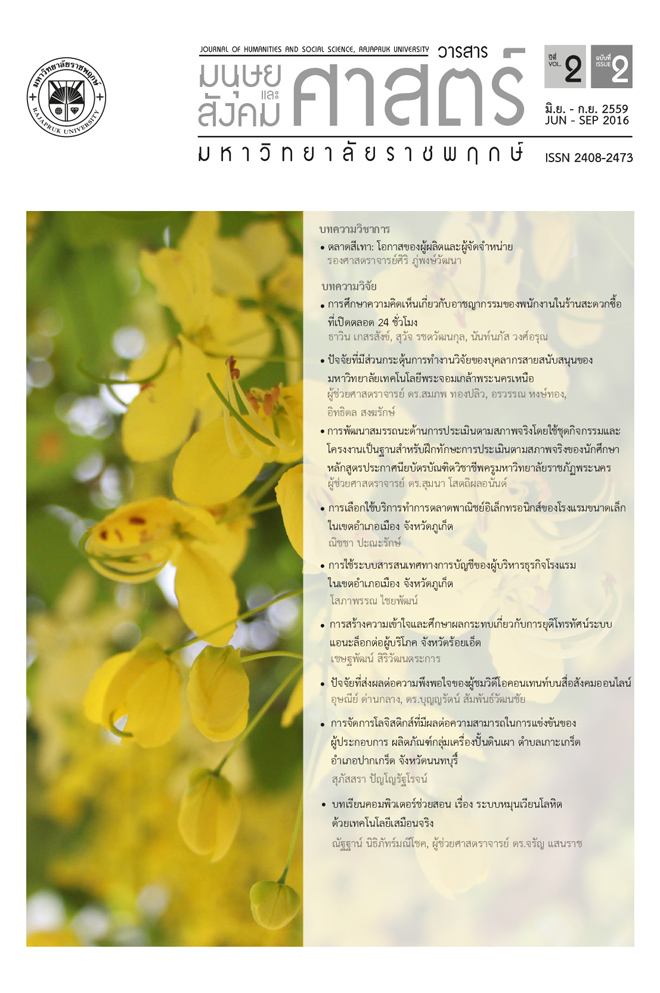Understanding and studying the effects of termination of analogue television system toward Roi-et’s consumers
Main Article Content
Abstract
This research aims 1) To explore the digital TV in Roi Et province 2) To study awareness of the people about the digital TV transition to digital TV. in Roi Et province. 3) To study satisfaction of the people who watch digital TV. in Roi Et province. The researchers collected data from 65,000 sample people in the analysis of quantitative data. Statistical software was used for finding frequency, percentage, average, and standard deviation.
Overall, 49,023 or 75.42 % of people in Roi Et currently watch TV via satellite, 7,730 people or 11.89% of antenna and 7,171people or 11.04% of cable TV as fallow. As Roi Et people, 35 298 or 54.30 percent of people known and can turn on and off the digital TV, 20,713 or 31.87 percent of people is an unknown digital TV and 13,567 people or 20.87 percent of people know and know how to adjust the station. The number of people who watch digital TV via satellite is 39,252 or 60.39 percent, 20,681 or 31.82 percent of people used old television and of and Digital 13,449 or 20.69 percent of people used TV HD (high definition). In addition, 43,144 or 66.38 percent of people want to convert to antenna receiver for digital TV and 21, 856 or 33.62 percent of people will not change.
Article Details
References
บุญชม ศรีสะอาด. (2527). การพัฒนาการสอน. กรุงเทพมหานคร: สุวีริยาสาส์น.
ประภาเพ็ญ สุวรรณ. (2520). ทัศนคติ : ในการวัด การเปลี่ยนแปลง และพฤติกรรมอนามัย.กรุงเทพมหานคร: ไทยวัฒนาพานิช.
ยุบล เบญจรงคกิจ. (2534). การวิเคราะห์ผู้รับสาร. กรุงเทพฯ : จุฬาลงกรณ์มหาวิทยาลัย.
ศิริชัย ศิริกายะ และ กาญจนา แก้วเทพ.(2531). ทฤษฎีการสื่อสารมวลชน. กรุงเทพฯ : คณะนิเทศศาสตร์ จุฬาลงกรณ์มหาวิทยาลัย.
สุรพงษ์ โสธนะเสถียร.(2533). การสื่อสารกับสังคม. กรุงเทพฯ : โรงพิมพ์จุฬาลงกรณ์มหาวิทยาลัย.
โสภิตสุดา มงคลเกษม.(2539). พฤติกรรมการเปิดรับข่าวสาร ความรู้ ทัศนคติและพฤติกรรมการคาดเข็ดขัดนิรภัยของผู้ขับขี่รถยนต์ ในกรุงเทพมหานคร, วิทยานิพนธ์นิเทศศาสตรมหาบัณฑิต คณะนิเทศศาสตร์ จุฬาลงกรณ์มหาวิทยาลัย.
อดุลย์ จาตุรงคกุล.(2541). หลักการตลาด. กรุงเทพฯ : มหาวิทยาลัยธรรมศาสตร์.
อัญชลี เฑียรฆชาติ.(2541). ปัจจัยที่มีผลต่อความพึงพอใจในงานและทัศนคติต่อการทำงานเป็นทีมของพนักงานในโรงงานอุตสาหกรรม. วิทยานิพนธ์มหาบัณฑิต มหาวิทยาลัยเกษตรศาสตร์.
อรวรรณ ปิลันธน์โอวาท.(2542). การสื่อสารเพื่อการโน้มน้าวใจ. พิมพ์ครั้งที่ 2. กรุงเทพมหานคร : โรงพิมพ์จุฬาลงกรณ์มหาวิทยาลัย.
Herbert C. Kelman. (1967). Attitude Change in Compliance, Identification and Internalization: Three Process of Attitude Change.John Wiley and Sons Inc, New York.
Katz E, Jay G. Blumler and Michale Gurevitch.(1974). The Used of Mass Communication: Current Perspectives on Gratifications Research.Beverly Hill:Sage Publications.
Katz, Elihu et al.(1974). Uses of Mass Communication by the Individual, Mass
Communication Research: Major Issues and Future Directions. W.Philip Davidson and Frederick Yu, Eds. New York: Praeger Publishers.
Wenner, Lawrence A.(1982). The Nature of Gratifications, in Media Gratifications
Research: Current Perspective. Beverly Hills, Sage Publications.
Yamane. (1967). Taro Statistic : An Introductory Analysis. New York: Harper &row.
Zimbardo and Ebbesen.(1969). Component of Attitude in Influencing Attitude and Changing Behavior. Addison-Wesley Publishing Company Inc, New York.


